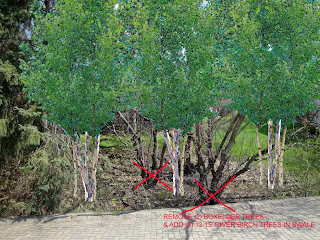Here is an article I just finished for Minnesota Nursery and Landscape Associations's The Scoop, January 2012 Edition:
"Perseverance, Adapting to Change and Reasserting Your Value."
By David Sonka, MNLA CP. Landscape Design Studios, LLC.
I feel the need to open with the same statement I have made a few times before, almost like it’s a creed. We landscape designers, collectively, are invaluable to this industry, serving as a vital link between the diverse needs of our clients with the growers, manufacturers, suppliers, garden centers, and contractors of Minnesota. Landscape designers employ many levels of knowledge and abilities in our services. It is important for us to uphold high professional standards and to recognize the value in the services we provide, so that the consumer will recognize the value in the services we provide for them. Don’t ever let yourselves be undervalued.
As the economic woes of the past three years ease up, and as I look ahead with optimism for an era similar to the glory days of the past, it is easy to be thankful. (It is Thanksgiving weekend as I write this, with the Scoop article being due a month in advance. Therefore, I am in an extra thankful mood.) I can easily be thankful for the people who have forged ahead in this economy and have made a concerted effort to sacrifice, adapt, and change in order to renew their business. And, in renewing their business, they have grown in ways which enable them to hire people, to patronize other businesses, and to continue supporting the health of their communities while stimulating the growth of the economy. I am thankful for those who have found it foolish to sit back and be idle, cynical, and complacent. I am thankful for those who find it almost unpatriotic or even un-Christian-like to deliberately prevent growth and bury their talents in the sand (or buy over-priced gold shares) rather than reinvest in real business and in the hiring of others to spur on growth. I am thankful for those who have persevered, who recognize that their home is a great investment, and that outdoor living is a great investment for their home. I am thankful for people who realize that outdoor living is an investment that they can immediately appreciate and enjoy, while their kids, friends, family members, and neighbors all can enjoy it with them. It is an investment that will certainly restore value into their home and improve their quality of life. I am certainly thankful for those folks who have hired me.
Persevering, to me, is adapting to change and reasserting your value. It is satisfying the innate need to survive, to press on, to succeed, and to win. And, if you happen to get knocked down you get right back up and try it again, but maybe try it a bit differently. It is what makes the inventors invent new products, the entrepreneurs unrelent in business, and the athletes circumvent the competition. It is what makes us, as an industry, produce things and constantly try to make them better, and effectively drive the healthy, production side of the American economy forward.
Since I am a fan of baseball, and the landscape season in Minnesota often parallels the season of professional baseball, I can easily find inspiration in certain Major League Baseball players. One player in particular that comes to mind is Joe Nathan, the former Minnesota Twins closing pitcher who is their all-time leader in saves with 260 in only 7 seasons. Unfortunately for me, Joe just signed a new $14.5M contract with the Texas Rangers. But he will go down as one of the most memorable characters of the Minnesota Twins organization from the last several years. He is a true example of someone who has persevered through setbacks, and has learned to adapt and reassert himself in making great comebacks into professional baseball.
Joe Nathan was a high school baseball player with slightly above-average talent at shortstop, barely making his way onto a Division III program in upstate New York. As a college player, his talent developed to a level where he was drafted in the 6th round to the San Francisco Giants, but the scouts looked at his 6’-4” frame and strong arm and wondered about his future as a pitcher rather than as an infielder. Joe’s dream was always to play shortstop in the major leagues, as he had only come in sporadically as a relief pitcher. But, as a mediocre rookie league player with a low batting average, he was told by the San Francisco Giants that he had no foreseeable future in baseball... unless he could take advantage of his build, strong arm, and raw talent in order to develop into a big league pitcher.
All players who get drafted into professional baseball as a pitcher have had dozens, if not hundreds of games under their belt where they have proven their talent, command of the strike zone, and competitive edge against the batters they face. As a right-handed pitcher, it usually takes three dominating pitches to make the big leagues, including a precision fastball averaging 90+mph and at least two effective off-speed pitches that can hit the strike zone at-will.
Again, it was a long shot for Joe Nathan having very little experience compared to his competition. At the time, Joe decided it would be best if he left the game and returned to college to finish up his degree in business over the next two years.
Meanwhile, it seems that some soul-searching and training on his own reinvigorated his passion. He decided it would be best to adapt, to accept the changes that he needed to make, and to reassert himself in order to succeed at the next level. This commitment to persevere is a commitment that Joe would make time and time again throughout his professional career in baseball.
A full two years later, he rejoined the Giants minor league squad, training hard in his new role as starting pitcher. In only two seasons, he advanced through the ranks of minor league baseball, making his major league baseball debut in 1999. By the 2000 season, he went from splitting time with the San Francisco Giants and their AAA team, and eventually earned a secure spot on the major league roster as a starting pitcher. However, by the end of the 2000 season, he required shoulder surgery which took the entire next two seasons to rehabilitate and regain his former capability. He did not return to regular duties with the San Francisco Giants until 2003, but in the process he struggled through miserable performances and pressed on, training, working, and recovering.
In the 2003 season, Joe saw action in 78 games, playing an effective role as a late-inning relief pitcher and setup man for closer Tim Worrell. His new role was to come in and throw his blazing 94 mph fastball, slashing curveball, and dropping change-up with the game on the line. For 0.1 to 3 innings he would exert everything he had, and that role would secure him on the Giants roster and payroll with $300,000.
Then, in 2004, the Minnesota Twins traded A.J. Pierzynski in order to promote a kid named Joe Mauer, and to bring Joe Nathan in as the hopeful replacement for “Everyday Eddie” Guardado in the role of their new, animated closing pitcher.
Twins fans like myself took an immediate liking to Joe Nathan. He was a guy who was visibly nervous, twitchy, and sweating buckets on the mound, often stepping back to towel off his own sweat with his jersey and take huge exaggerated breaths as if he was going to have an anxiety attack. But you could see his determination. He was going to give everything he had with each pitch, and do everything possible to close the game and seal the win. And, 260 times over, that is exactly what he did.
In 2004-2009, Joe Nathan saved between 36-47 games each season for the Minnesota Twins, helping them achieve American League Central Division titles in three seasons. Joe earned a spot on the MLB All-Star Game four times, and received votes for AL MVP and the AL Cy Young Award in two of those seasons. His salary negotiations with the Twins went from $440,000 steadily up to $11.25M. He was one of the very elite and most effective in his profession.
Then, right at the start of the 2010 season, at 35 years old, Joe tore his ulnar collateral ligament in his elbow. This requires the procedure called “Tommy John Surgery” which involves transplanting a new ligament into the elbow followed by 12 months of intensive rehabilitation and conditioning.
Once again, Joe had to persevere. As a 36 year old man, he was once again fighting for his career. It was well-documented that he worked through his rehabilitation and conditioning routines with diligence, making the commitment to get back with his friends on the ball field the following season. Though the 2011 season was a forgettable one for the Minnesota Twins, Joe made it back and showed his capability once more. Unfortunately, the Texas Rangers were able to maneuver a deal with Joe Nathan, placing him on a team with two consecutive World Series appearances and very likely improving his chance to be on a Championship team before he retires from baseball. The deal will also earn him another $14.5M over the next two seasons. Once again, he has hit the jackpot.
To me, Joe Nathan serves as another great example and role model for somebody who can adapt to change and reassert his value in his profession. Translated to my profession, I don’t have anything close to $14.5M coming in the next two years, but I do have the ability to continue to adapt, and to improve what I do and how I do it, for the betterment of my career and for the betterment of others I work with.
I have the ability to help companies in need, getting their projects to move forward so they can grow their businesses. I have the ability to advance the concept of outdoor living and customized landscapes as a worthy investment, so that it can be seen as a valuable asset for the home. I have the ability to illustrate landscapes in a way which homeowners can see the value in it, with landscape design being a vital service in a home improvement project… In fact, we all do.
We all can use landscape design as a way to add value in our services, as a valuable service, in order to grow business and increase project values. This will improve property values, increase jobs, and circulate dollars into the American economy to help finalize the economic recovery. We are small American companies with American workers, supporting American families, and installing American-made goods. We have the ability, and we can do it.


























































